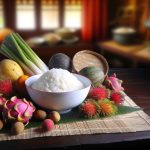Introduction to Eastern Medicine and Nutrition
Understanding Eastern Medicine
Eastern medicine, also known as Traditional Chinese Medicine (TCM), is a holistic approach to health that has been practiced for thousands of years. It encompasses a range of practices, including acupuncture, herbal medicine, and qigong, with a focus on balancing the body’s vital energy, or Qi. Central to TCM is the belief that the body is a microcosm of the universe, and health is achieved by maintaining harmony within the body and between the body and the natural world.
The Concept of Yin and Yang in Diet
The principle of Yin and Yang is a fundamental concept in Eastern philosophy, representing the dual nature of all things. In the context of nutrition, foods are categorized as Yin, Yang, or neutral, each affecting the body’s energy balance differently. Yin foods are typically cooling and moistening, ideal for balancing excess heat in the body, while Yang foods are warming and drying, suitable for combating cold and dampness. Neutral foods provide balance and are generally suitable for all body types.
Comparing Eastern and Western Nutrition Philosophies
Western nutrition often emphasizes the biochemical aspects of foods, focusing on calories, macronutrients, and vitamins. In contrast, Eastern nutrition views food through a lens of energy and balance, considering the thermal nature and energetic properties of foods and how they interact with the individual’s constitution. While Western nutrition is largely standardized, Eastern nutrition is highly personalized, taking into account the individual’s health, environment, and the current season.
The Importance of Balance in Diet
In Eastern medicine, the balance of Yin and Yang in the diet is crucial for maintaining health and preventing disease. An imbalance can manifest in various symptoms and health issues. For instance, an excess of Yin may lead to coldness and lethargy, while an excess of Yang may result in inflammation and restlessness. By incorporating a variety of foods that include all five flavors—sweet, sour, bitter, pungent, and salty—and balancing the thermal nature of foods, one can achieve a diet that promotes harmony and supports the body’s natural healing processes.
Ultimately, Eastern nutrition is not just about feeding the body but nourishing the whole person—mind, body, and spirit. By understanding and applying the principles of Yin and Yang, individuals can create a diet that is not only nutritious but also tailored to their unique needs, leading to enhanced well-being and vitality.
Fundamentals of Yin and Yang Foods
Characteristics of Yin Foods
Yin foods are typically associated with cooling properties and are believed to be beneficial for individuals with excess heat in their bodies. These foods are often described as moistening and nourishing, which can help to balance internal dryness. Common characteristics of Yin foods include a high water content, a green or vibrant color, and a sweet or bland taste. Examples of Yin foods are watermelon, cucumber, tofu, and leafy greens like spinach. Yin foods are often recommended during warmer seasons or for those experiencing symptoms such as inflammation or restlessness.
Characteristics of Yang Foods
Yang foods, on the other hand, are warming and invigorating. They are typically used to combat cold or damp conditions within the body. Yang foods often have a pungent, spicy, or aromatic flavor and are rich in proteins or fats. Common examples include ginger, garlic, red meat, and spices such as cinnamon and cloves. These foods are thought to stimulate the body’s internal heat, improve circulation, and boost energy levels, making them suitable for colder climates or for individuals feeling fatigued or weak.
Neutral Foods in Eastern Medicine
In the context of Eastern medicine, neutral foods are those that do not significantly affect the body’s balance of Yin and Yang. They are considered stabilizing and can be consumed by most individuals without concern for disrupting their internal harmony. Neutral foods include staples like rice, potatoes, and certain legumes. These foods provide a balanced energy source and are often used as a foundation in meals to complement both Yin and Yang foods.
The Impact of Cooking Methods on Yin and Yang
The preparation and cooking methods of food can also influence its Yin or Yang qualities. For instance, raw or lightly cooked foods tend to retain more of their Yin properties, while grilled, roasted, or fried foods are enhanced in Yang due to the added heat and often reduced moisture content. Steaming and boiling are considered gentle cooking methods that preserve the inherent nature of the food, making them suitable for maintaining balance. Understanding these effects can help individuals tailor their cooking techniques to their body’s needs, promoting better digestion and overall well-being.
Integrating Yin and Yang into Your Diet
Assessing Your Body’s Needs
Before integrating the principles of Yin and Yang into your diet, it is crucial to assess your body’s individual needs. Traditional Chinese Medicine (TCM) teaches that each person has a unique balance of Yin (cooling, moistening) and Yang (warming, drying) energies. Observing your body’s reactions to different foods and climates, as well as any symptoms of imbalance such as fatigue, stress, or digestive issues, can provide insights into your personal Yin and Yang dynamics. Consulting with a TCM practitioner can also offer a more in-depth understanding of your body’s constitution and guide you towards a diet that harmonizes your specific Yin and Yang energies.
Creating a Balanced Meal Plan
Once you have a grasp of your body’s needs, you can begin to create a meal plan that promotes balance. Incorporating a variety of foods with different thermal properties and flavors is key. For example, if you have an excess of Yang, you might focus on adding more Yin foods like cucumbers, watermelon, and leafy greens to your meals. Conversely, those with a Yin excess may benefit from Yang foods such as ginger, garlic, and lean meats. It’s important to include neutral foods like rice and potatoes, which help to maintain equilibrium. Additionally, the Five Flavors—sweet, sour, bitter, pungent, and salty—should be represented to nourish all organ systems adequately.
Seasonal Eating and Food Energy
Eating with the seasons is a fundamental aspect of TCM nutrition. Each season aligns with certain elements and organ systems, and by choosing seasonal foods, you can support your body’s natural rhythms. In spring, focus on fresh greens and sprouts to cleanse the liver. Summer’s heat calls for cooling foods like fruits and salads, while late summer’s dampness can be balanced with root vegetables and grains. In autumn, pungent foods support the lungs, and in winter, warming foods help nourish the kidneys. By aligning your diet with the seasons, you can optimize your body’s energy, or Qi, and promote a harmonious balance of Yin and Yang.
Mindful Eating Practices
Mindful eating is a practice that encourages being fully present and aware during meals. It involves paying attention to the flavors, textures, and sensations of your food, as well as your body’s hunger and fullness cues. This practice can enhance the enjoyment of your meals and help you tune into your body’s needs, making it easier to maintain a balanced diet. Mindful eating also allows you to observe how different foods affect your energy and mood, further informing your dietary choices to support a harmonious balance of Yin and Yang.
In conclusion, integrating Yin and Yang into your diet involves a thoughtful assessment of your body’s needs, creating a balanced meal plan that includes a variety of thermal properties and flavors, eating seasonally to align with natural cycles, and practicing mindful eating. By embracing these principles, you can enhance your overall well-being and achieve a more balanced state of health.
Case Studies: Yin and Yang Diet Success Stories
Chronic Conditions and Dietary Adjustments
Eastern medicine’s approach to nutrition emphasizes the importance of balance and harmony within the body. This principle has been particularly effective in managing chronic conditions. For instance, a patient with chronic inflammation, considered an excess of Yang, may benefit from incorporating more Yin foods into their diet, such as leafy greens and fruits, to counteract the heat and restore equilibrium. Similarly, individuals with chronic fatigue, often seen as a deficiency in Yang, have experienced improved energy levels by adding warming spices and proteins to their meals. These dietary adjustments, rooted in the Yin and Yang philosophy, have led to significant improvements in patients’ overall well-being.
Weight Management through Balance
Weight management is another area where the Yin and Yang of nutrition has shown promising results. A balanced diet that aligns with an individual’s unique energetic constitution can lead to natural weight regulation. For example, a person with a Yin constitution who struggles with weight gain may find success by reducing cold and raw foods, which can dampen digestive fire, and instead focusing on warm, cooked meals that enhance metabolic activity. Conversely, someone with a Yang constitution might benefit from cooling foods to prevent overstimulation of the system. These tailored approaches help individuals achieve and maintain a healthy weight without extreme diets or calorie counting.
Energy Levels and Mental Clarity
The concept of Yin and Yang extends beyond physical health to mental and emotional well-being. Case studies have shown that diets lacking in balance can lead to mental fog and lethargy. By adjusting their diets to include a harmonious mix of Yin and Yang foods, individuals have reported increased mental clarity and sustained energy throughout the day. This balance ensures that the body receives a steady supply of nutrients that support cognitive function and vitality.
Digestive Health Improvements
Eastern medicine views the digestive system as a central element in health and wellness. A diet that respects the Yin and Yang balance can lead to significant improvements in digestive health. Patients with symptoms of digestive distress have found relief by incorporating principles of Eastern nutrition, such as eating seasonally and including a mix of cooked and raw foods to support the spleen and stomach. These practices have not only alleviated symptoms but also enhanced the body’s ability to absorb and utilize nutrients.
These success stories illustrate the potential of integrating Eastern medicine concepts into dietary practices. By understanding and applying the principles of Yin and Yang, individuals can achieve a state of balance that promotes health, prevents disease, and enhances the quality of life.
Common Misconceptions about Eastern Nutrition
Myth vs. Reality: Understanding the Science
When it comes to Eastern nutrition, particularly Traditional Chinese Medicine (TCM), there are numerous misconceptions that can lead to confusion and skepticism. One common myth is that TCM dietary principles are based solely on ancient beliefs without scientific backing. In reality, TCM is a complex system that considers the energetic properties of foods and their effects on the body’s balance. While Western nutrition often focuses on the biochemical composition of foods, TCM emphasizes the importance of harmony and balance, taking into account individual needs and environmental factors. Scientific studies have begun to explore the mechanisms behind TCM concepts, such as the effects of warming and cooling foods on the body, providing a bridge between traditional knowledge and modern science.
The Role of Supplements in an Eastern Diet
Another misconception is that Eastern diets heavily rely on supplements and exotic ingredients. While herbs and supplements can play a role in TCM, they are typically used to support, rather than replace, a balanced diet. The emphasis is on consuming a variety of foods with different energetic qualities to maintain health. For instance, incorporating both Yin cooling tonic foods like watermelon and Yang warming tonic foods like ginger can help achieve dietary balance. Supplements are considered a targeted intervention for specific imbalances, not a daily necessity for everyone.
Addressing Skepticism Towards Non-Western Diets
Skepticism towards non-Western diets often stems from a lack of understanding and the perception that these diets are not evidence-based. Addressing this skepticism involves education and an open dialogue about the principles of Eastern nutrition. It’s important to acknowledge the growing body of research that supports the health benefits of various components of Eastern diets, such as the consumption of fermented foods, green tea, and plant-based ingredients. Additionally, the holistic approach of TCM, which includes diet, lifestyle, and mindfulness practices, aligns with the contemporary focus on whole-person wellness. By highlighting the similarities between Eastern and Western nutritional philosophies, such as the importance of balance and moderation, we can foster a more inclusive view of global dietary practices.
Practical Tips for Incorporating Eastern Concepts into Western Diets
Shopping for Yin and Yang Foods
When embarking on a journey to balance your diet with Eastern nutritional principles, the first step is to identify and purchase Yin and Yang foods. Yin foods are typically cooling and include items such as fruits, leafy greens, and dairy products. Yang foods, on the other hand, are warming and often encompass meats, spices, and root vegetables. To incorporate these concepts into your shopping routine, create a balanced list that includes a variety of both Yin and Yang foods. Seek out fresh, organic produce and high-quality meats, as the quality of food can affect its energetic properties.
Adapting Recipes for Balance
Adapting your favorite Western recipes to include Eastern nutritional concepts can be both fun and beneficial for your health. Aim to achieve a balance of Yin and Yang in each meal. For instance, if you’re preparing a dish that is predominantly Yang, such as a spicy beef stir-fry, consider adding Yin elements like cucumber or tofu to cool down the dish. Conversely, if you’re making a Yin-heavy salad, sprinkle in some seeds or nuts to add Yang energy. The key is to strive for harmony and moderation in flavors and ingredients.
Combining Eastern and Western Dietary Practices
Integrating Eastern dietary concepts doesn’t mean abandoning Western nutritional science. Instead, combine the strengths of both. For example, use the Western emphasis on macronutrients to ensure you’re getting enough protein, fats, and carbohydrates, while applying Eastern principles to select specific foods within these categories that promote balance. Embrace the Eastern practice of mindful eating by taking the time to enjoy your meals without distractions, which can lead to better digestion and satisfaction.
Listening to Your Body’s Signals
One of the most important aspects of Eastern nutrition is the emphasis on individual needs and responses. Pay attention to how different foods make you feel. If you notice certain foods cause discomfort or imbalance, consider their Yin or Yang properties and adjust accordingly. For example, if you feel lethargic after eating a meal heavy in Yin foods, you may need to incorporate more Yang foods to restore balance. Keeping a food diary can be a helpful tool in tracking your body’s reactions and tailoring your diet to your unique constitution.
By shopping mindfully, adapting recipes, combining dietary practices, and listening to your body, you can successfully integrate the wisdom of Eastern nutrition into your Western diet, leading to a more balanced and holistic approach to health.
Conclusion: Embracing the Yin and Yang for Holistic Health
Summary of Key Takeaways
In our journey through the principles of Eastern medicine and its application to nutrition, we’ve uncovered the profound wisdom of balancing Yin and Yang in our diets. This ancient philosophy emphasizes the importance of harmony and balance in our food choices, recognizing that what we eat significantly impacts our physical, mental, and emotional well-being. By understanding the characteristics of Yin and Yang foods, we can tailor our diets to our body’s needs, promoting optimal health and preventing illness.
Key takeaways include the recognition of individual constitution in dietary planning, the significance of seasonal eating, and the benefits of mindful eating practices. Additionally, we’ve seen how integrating these concepts can lead to improvements in chronic conditions, weight management, energy levels, and digestive health. By debunking common misconceptions, we’ve paved the way for a more informed approach to incorporating Eastern nutrition principles into Western diets.
The Future of Nutrition: A Blended Approach
Looking ahead, the future of nutrition is poised to embrace a blended approach that combines the best of Eastern and Western philosophies. This integrative model will likely focus on personalized nutrition, acknowledging the unique needs of each individual while drawing on a diverse array of dietary wisdom. As research continues to evolve, we can expect a growing appreciation for the role of food energetics, the gut-brain connection, and the anti-inflammatory properties of certain foods in maintaining holistic health.
The synergy between nutritional science and traditional dietary practices promises a more comprehensive understanding of how to nourish our bodies effectively. Embracing this blended approach can lead to more nuanced and effective strategies for disease prevention, health promotion, and the optimization of overall well-being.
Continuing Your Journey in Balanced Eating
As we conclude, it’s important to recognize that the journey to balanced eating is ongoing and personal. It involves continuous learning, experimentation, and adaptation. To further this journey, consider the following steps:
- Engage with qualified practitioners who can provide personalized guidance based on your health needs and goals.
- Experiment with different foods and cooking methods to discover what best supports your balance of Yin and Yang.
- Stay informed about the latest research and developments in the field of nutrition and Eastern medicine.
- Practice mindful eating to deepen your connection with food and its impact on your body.
By embracing the principles of Yin and Yang in our diets, we open ourselves to a world of holistic health benefits. This balanced approach to eating is not just about the foods we consume; it’s about nurturing a harmonious relationship with our bodies and the environment. As we integrate these timeless concepts into our modern lives, we can look forward to a future where nutrition is truly seen as a form of medicine, capable of healing and sustaining us in the most natural and nurturing ways.
READ MORE: 9 Health Benefits Of Qigong
Sources:
https://shawellness.com/shamagazine/en/yin-and-yang-foods/
https://albanacupuncture.com/eating-with-yin-and-yang-understanding-chinese-medicine-nutrition/
https://www.health.harvard.edu/blog/nutritional-psychiatry-your-brain-on-food-201511168626
https://www.alimentarium.org/en/story/yin-and-yang-kitchen









